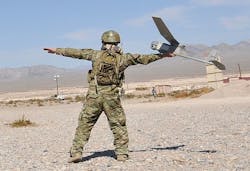L-3 EO Sonoma to integrate large-area electro-optical UAV sensor payloads for small platforms
Officials of the U.S. Naval Research Laboratory (NRL) at Stennis Space Center, Miss., are asking L-3 EO Sonoma to build and test a large-area airborne sensor that can operate even from hand-launched UAVs. It's part of NRL's Tactical Infrared Night Surveillance System (TNWAS) project.
L-3 EO Sonoma engineers will develop a UAV sensor payload able to conduct precise, large-area, high-resolution day and nighttime surveillance of large areas in a configuration meeting the extremely tight size, weight, and power constraints of the Navy and U.S. Marine Corps Small Tactical Unmanned Air System (STUAS) aircraft. The contract is for $930,110.
STUAS aircraft include the 2.8-pound AeroVironment RQ-12A Wasp IV; the 4.7-pound AeroVironment RQ-11B Raven; the 13.5-pound AeroVironment RQ-20B Puma; the 48-pound Boeing Insitu ScanEagle; the 75-pound Textron AAI Aerosonde; and the 135-pound Boeing Insitu RQ-21A Blackjack.
NRL already has sponsored development of the TNWAS infrared sensor, which is designed to operate together with an NRL-developed video processor to comprise the TNWAS airborne surveillance system, which went through ground testing last December.
The TNWAS infrared sensor integrates components like the optics and pointing mirror assembly from the Office of Naval Research (ONR) UltraWide Optics program; and the integrated Dewar cooler assembly (IDCA) from the ONR 8K Focal Plane Array program.
Now L-3 EO Sonoma experts will find ways to stabilize the sensor's sightline against effects of UAV motion and vibration; provide precise measurement of sightline direction to support geolocation of ground objects; and integrate the sensor with the NRL video processor.
Then company experts will demonstrate the integrated system in truck-based and airborne tests.
Related: Sensor payloads for unmanned vehicles
The contract's first phase focuses on collecting high-quality imagery and determining sightline pointing direction in a mobile ground environment. This involves completing the L-3-developed TNWAS sensor controller computer to communicate with the NRL payload system computer.
If these tests satisfy Navy requirements, then L-3 EO Sonoma engineers will integrated the sensor system aboard a remotely operated aircraft that functions vial data links.
For more information contact L-3 EO Sonoma online at www2.l3t.com/sonomaeo, or the Naval Research Lab at Stennis Space Center at www.nrl.navy.mil/field-sites/stennis.
Ready to make a purchase? Search the Military & Aerospace Electronics Buyer's Guide for companies, new products, press releases, and videos
